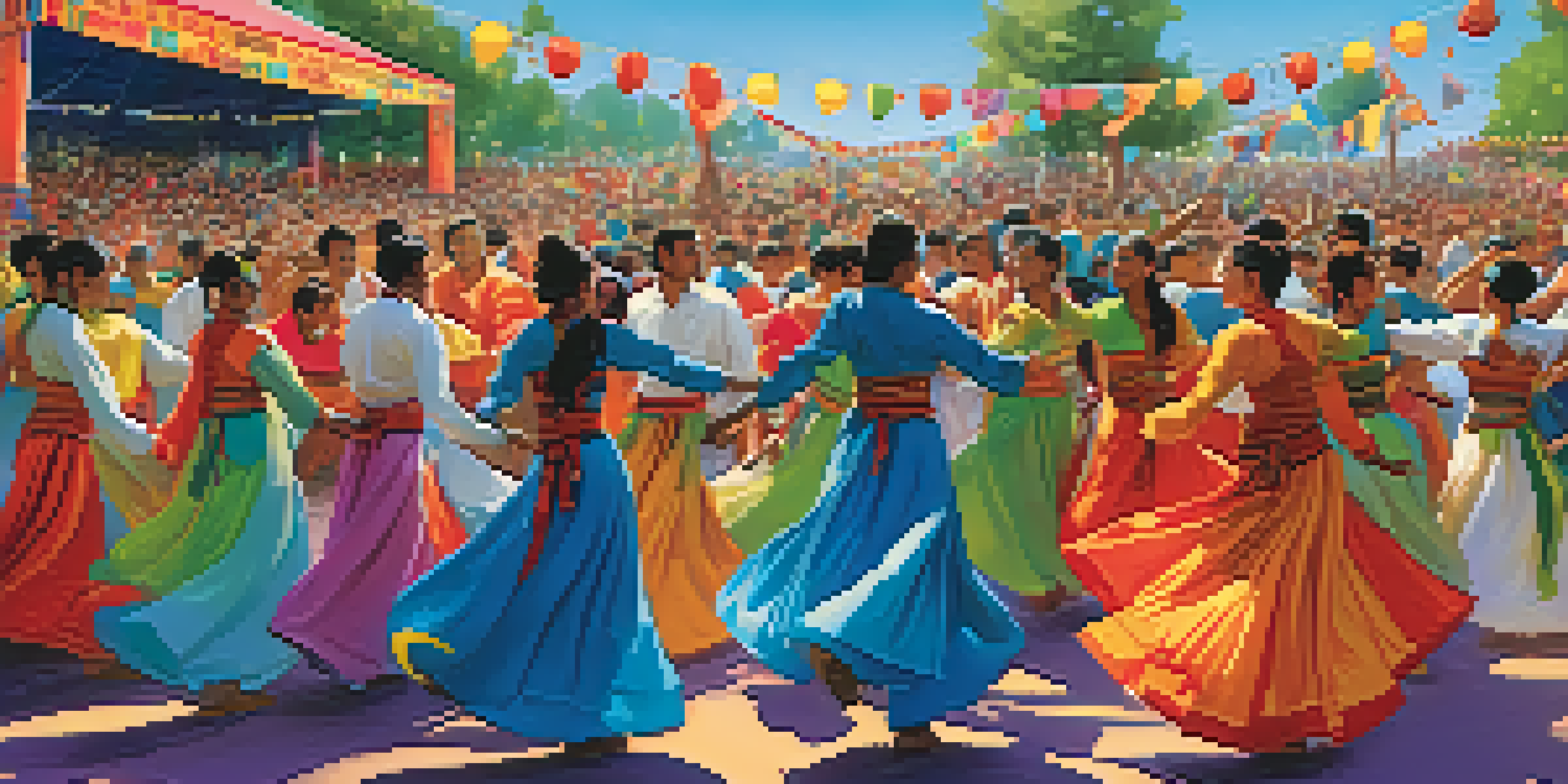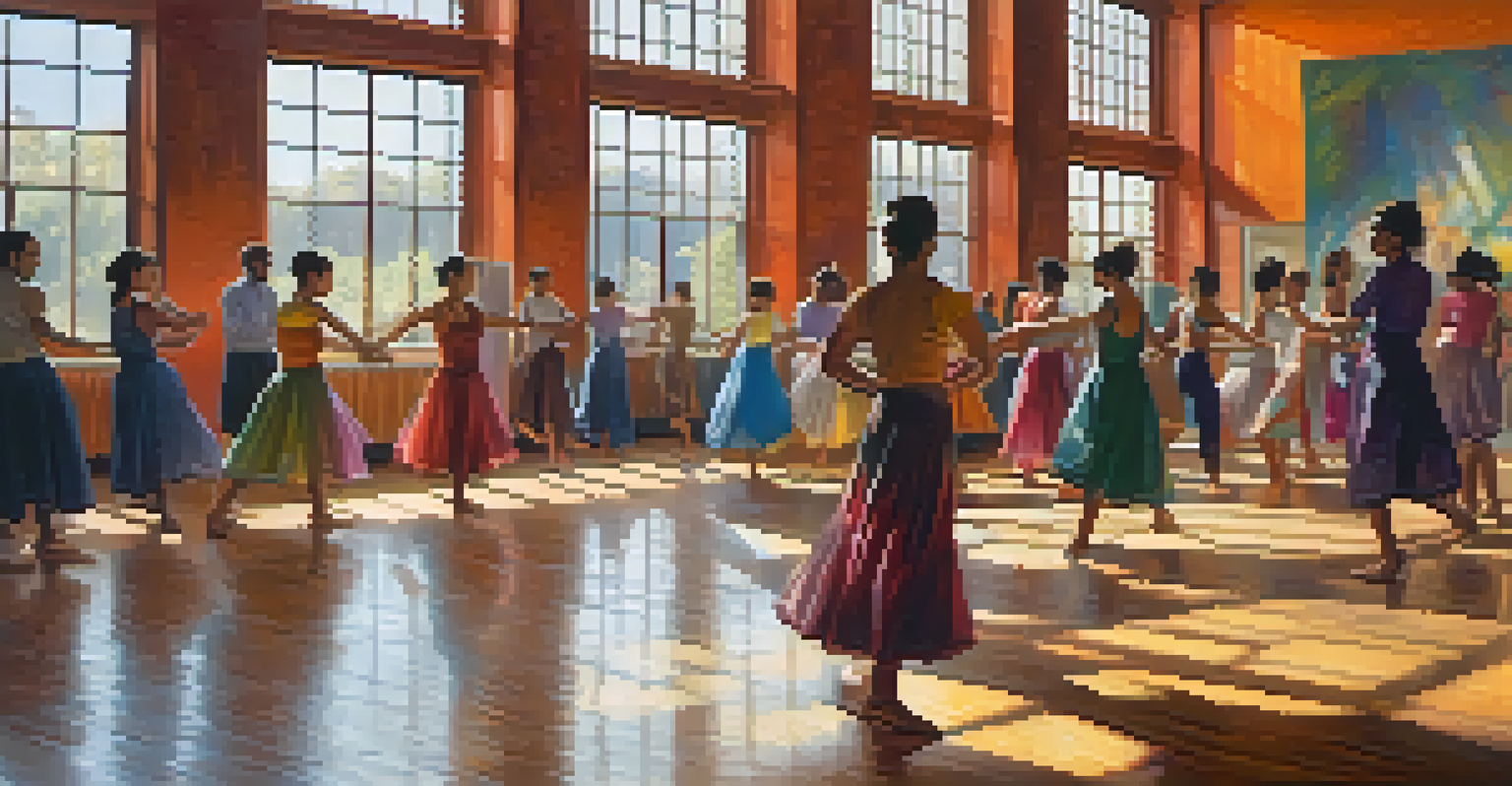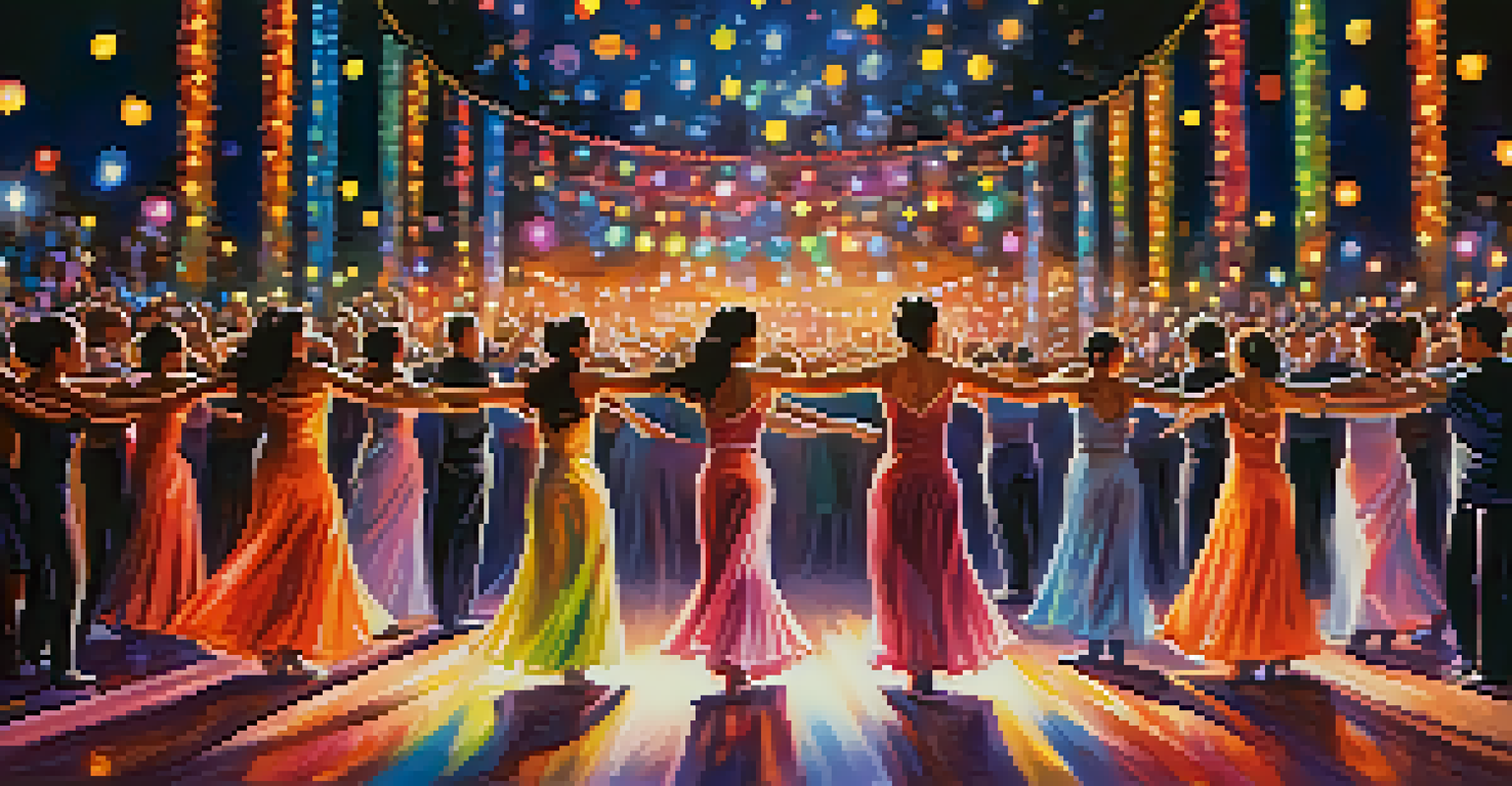The Significance of Dance Festivals in Cultural Exchange

Dance Festivals: A Celebration of Diversity and Unity
Dance festivals serve as vibrant platforms where diverse cultures converge, celebrating their unique forms of expression. Participants and audiences alike experience a rich tapestry of movements, rhythms, and traditions. This celebration fosters a sense of unity, reminding us that despite our differences, we share a common love for art and movement.
Dance is the hidden language of the soul.
The energy of a dance festival is contagious, drawing people from all walks of life. As attendees immerse themselves in performances, they gain insights into customs and traditions that may differ from their own. This exposure not only broadens perspectives but also encourages respect and appreciation for cultural diversity.
Moreover, dance festivals often feature workshops and collaborative performances, allowing participants to learn from one another. In these settings, dancers exchange techniques and stories, creating a communal bond that transcends language barriers. Ultimately, these shared experiences promote a deeper understanding of one another's cultures.
Cultural Exchange Through Dance: Bridging Gaps
Dance is a universal language, capable of conveying emotions that words often cannot express. At dance festivals, this language becomes a bridge, connecting people from various backgrounds. Festivals provide a space where stories of struggle, joy, and unity are communicated through movement.

When dancers showcase their traditional styles, they invite others to witness their heritage firsthand. This exposure can challenge stereotypes and assumptions, fostering empathy and dialogue. In essence, dance festivals serve as a reminder that our shared humanity can shine through, regardless of cultural differences.
Dance Festivals Unite Diverse Cultures
Dance festivals create a vibrant space for cultural exchange, allowing participants to share and appreciate diverse traditions through movement.
Additionally, the collaborative nature of many dance festivals encourages cross-cultural partnerships. Dancers may fuse different styles, creating innovative performances that reflect a blend of traditions. This not only enriches the art form but also deepens the bonds between communities, promoting lasting connections.
The Role of Technology in Dance Festivals
In today's digital age, technology plays a pivotal role in enhancing the experience of dance festivals. Live streaming and social media allow audiences from around the world to participate in these events virtually. This expansion of reach enables cultural exchange on a global scale, breaking geographical barriers.
The dance is a poem of which each movement is a word.
Furthermore, digital platforms create opportunities for dancers to share their artistry beyond the festival stage. Online collaborations and workshops foster connections that might not have happened otherwise, allowing for continuous learning and growth. This dynamic use of technology amplifies the impact of cultural exchange.
However, it’s essential to balance the digital experience with the in-person connection that festivals provide. The thrill of watching a performance live, feeling the energy of the crowd, and engaging directly with artists is irreplaceable. The blend of technology and traditional festival experiences can create a richer cultural exchange.
Economic Impact of Dance Festivals on Local Communities
Dance festivals often have a significant economic impact on their host communities. As tourists flock to these events, local businesses benefit from increased foot traffic and sales. Hotels, restaurants, and shops thrive, showcasing the positive correlation between cultural events and economic growth.
Moreover, the influx of visitors creates job opportunities, ranging from event planning to hospitality services. This economic stimulation can lead to long-term benefits for the community, allowing for further investment in cultural initiatives. It’s a win-win situation where culture and commerce go hand in hand.
Economic Growth from Cultural Events
These festivals boost local economies by attracting tourists, increasing business for hotels and restaurants, and creating job opportunities.
Additionally, when local artists participate in these festivals, they gain exposure and recognition, which can elevate their careers. This support for local talent not only enriches the festival experience but also contributes to a thriving arts scene in the community. Festivals, therefore, become catalysts for both cultural pride and economic development.
Dance Festivals as Platforms for Social Change
Many dance festivals take on social themes, using the medium to raise awareness about important issues. By incorporating messages of equality, environmentalism, or social justice into their performances, artists can inspire change and provoke thought. This transformative potential underscores the role of dance as a tool for activism.
For instance, festivals that highlight marginalized voices can empower communities and facilitate dialogue about pressing issues. When audiences witness these performances, they are often moved to reflect on their values and beliefs. This engagement can lead to a greater understanding and appreciation of various social causes.
Moreover, by providing a platform for underrepresented groups, dance festivals promote inclusivity and diversity. They create spaces where all voices can be heard, ensuring that the festival experience is enriching for everyone involved. In this way, dance becomes a powerful medium for fostering social change.
The Evolution of Dance Festivals Over Time
Dance festivals have evolved significantly over the years, adapting to cultural shifts and societal changes. Initially rooted in traditional practices, many festivals now showcase contemporary styles and innovative choreography. This evolution reflects the dynamic nature of dance, continually responding to the world around it.
As globalization increases, dance festivals have also begun to incorporate influences from various cultures, resulting in exciting hybrid styles. This blending of traditions not only keeps the art form fresh but also highlights the interconnectedness of global cultures. Festivals act as a mirror, reflecting the changing landscape of society through dance.
Dance as a Tool for Social Change
Many dance festivals address social issues through performances, fostering dialogue and promoting inclusivity among marginalized voices.
Furthermore, the growing emphasis on diversity within festival lineups ensures representation across different cultures and dance styles. This commitment to inclusivity enriches the festival experience, making it a true celebration of global artistry. Ultimately, the evolution of dance festivals demonstrates the resilience and adaptability of cultural expression.
The Future of Dance Festivals in a Globalized World
As we look to the future, dance festivals will likely continue to play an essential role in promoting cultural exchange. With an increasingly interconnected world, these events can serve as focal points for fostering understanding and collaboration. The potential for cultural dialogue through dance is limitless.
Moreover, the emergence of new technologies and platforms will further enhance the festival experience. Virtual reality and augmented reality could allow audiences to engage with performances in unprecedented ways, deepening their understanding of different cultures. This innovation promises to keep dance festivals relevant in a rapidly changing world.

However, it is crucial for organizers to prioritize authenticity and inclusivity as they embrace these advancements. Maintaining the core values of cultural exchange and community connection will be key to preserving the essence of dance festivals. By doing so, these events can continue to inspire unity and understanding for generations to come.